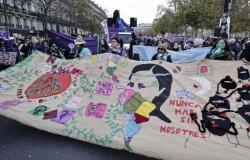The deployment of the ZTL in the Paris city center this Monday, November 4, did not escape criticism from the opposition and traders. Fears focus on the loss of customers, the postponement of traffic or even the implementation of controls. The town hall and experts want to be reassuring.
This is a small revolution for motorists used to traveling through the city center of Paris. The limited traffic zone (ZTL) comes into force from this Monday in the first four districts of the capital. 5.5 km² prohibited to motorized vehicles «transit», that is to say those who simply pass by, except for emergency vehicles, buses, taxis, people with reduced mobility, motorists residing or working there. Traffic “destination” is also allowed, namely those whose departure and arrival points are in the sector, for a medical appointment, shopping, going to the cinema… Ariel Weil, mayor of Paris Center (the 1st, 2nd, 3rd and 4th arrondissements of Paris), hopes to see a drop in traffic “10 to 15%”. A device, according to him, “very effective in combination with the effects of the modification of the traffic plan for Paris Center” so that this area is no longer a “shortcut”.
But this new measure, which aims to limit very heavy traffic in this area as well as noise and air pollution, has been strongly criticized by the right-wing municipal opposition. In a press release, the Changer Paris group, which mainly brings together Republican elected officials, criticizes a system to “zero ecological impact” and which promotes “the eviction of Parisians for the benefit of tourists”. “Monitoring compliance with this ZTL will be very poorly ensured and will give rise to new Kafkaesque bureaucratic constraints for Parisians,” they add.
A loss of customers for stores?
Some traders also fear an impact on their turnover. Le Figaro questioned several of them. “It’s going to be a disaster. My clientele is mainly made up of tourists but at lunchtime, I have a lot of workers who normally stop by car. explains the manager of a bakery. A representative of the neighborhood's traders located in the 4th arrondissement is even more categorical: “If the municipality wants to kill local commerce, it cannot do it better.” “The game of massacre of original and atypical businesses which contribute to the soul of Paris Center continues with the ideological ZTL”believes on X Aurélien Véron, elected to the Paris council and spokesperson for the Changer Paris group.
However, according to experts on urban travel issues, these concerns are unfounded. According to Lucile Ramackers, urban mobility consultant, “there have been quite a few studies and counter-examples on transit traffic: in reality, people don't stop somewhere by chance. And finally, transit traffic mainly represents nuisances for the activity and for local residents.” An opinion shared by Mathieu Chassignet, engineer specializing in sustainable mobility, who points out that a recent study by the Atelier Parisien d'urbanisme shows that only 3% of customers who go to Paris Center do so by car. “Ultimately with less through traffic, it will be more pleasant for pedestrians and for cyclists who will come more often to consume in this area,” he summarizes. Mathieu Chassignet adds that other cities which have implemented this system “despite an initial outcry” traders “realize that they are benefiting from it and then they ask for it to be extended”. Ariel Weil recalls that the town hall took the decision not to pedestrianize the hypercenter of Paris and that “deliveries and customers will still be able to come on site. We even went further with a total exemption for traders and craftsmen. he specifies.
“A reduction in noise pollution and emissions” in Barcelona and London
The opposition also fears that traffic in neighboring districts will explode. “Traffic postponements could reach up to 40% on certain axes,” says Changer Paris, simply moving pollution and nuisances to other neighborhoods. A consequence that the specialists interviewed by Liberation share, while tempering it. “It may be complicated for a while. But then people get used to it and there is a system of traffic evaporation. We notice that after a while, there are just fewer car trips. For the cases of Barcelona and London, where this system has been implemented in certain places, we see a reduction in both noise pollution and emissions. explains Lucile Ramackers. Same observation for Mathieu Chassignet: “There is definitely a small increase in traffic. But it will be on boulevards that can absorb it. And we must not forget that in this kind of situation, part of the traffic disappears because people will ultimately start using other modes of travel.”
Controlling vehicles that ignore the rules also raises questions. Judged “blurred” by the opposition, the town hall initially wants them to be carried out randomly by municipal police officers before potentially setting up an automatic control system. “Italy is ahead on this. We can track a license plate and calculate that the car didn't stop to run an errand or go to a restaurant. It's quite easy when you can estimate the route covered and the time. explains Lucile Ramackers. Ariel Weil may be “very supportive” to video verbalization using surveillance cameras, the system cannot yet be implemented, due to lack of a legislative framework that allows it.






